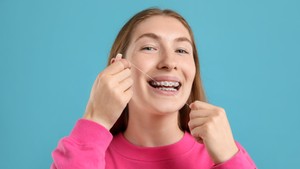Figuring out how to floss with braces can feel challenging at first, but the right technique makes daily care straightforward and effective.






Save $250 off braces or Invisalign!*
Schedule your appointment online.
Figuring out how to floss with braces can feel challenging at first, but the right technique makes daily care straightforward and effective. When you ask, “how can you floss with braces?” the answer is that a consistent, gentle approach works best. In this guide, you’ll learn why braces and flossing go hand in hand during orthodontic treatment, how to use traditional floss correctly, and which alternative tools can simplify the process. Whether you’ve just started braces or want to improve your hygiene habits, the focus is on comfort, consistency, and results, so you can maintain excellent oral health and stay on track with your orthodontic goals.
Why Flossing with Braces Is Essential
Braces reshape your smile, and they also change how you care for your teeth day to day. Brackets and wires introduce more angles and tight spaces where food and plaque can accumulate, making thorough cleaning more important. If you’re wondering how you can floss with braces, start by understanding what flossing prevents and why braces and flossing together support successful treatment.
Flossing removes plaque between teeth and beneath the archwire, areas your toothbrush can’t reach well. Without routine flossing, plaque can harden into tartar, which is difficult to remove and may increase your risk of cavities around brackets, along the gumline, and near the edges of enamel. Consistent flossing also helps prevent white spot lesions, a common side effect of plaque left around braces. Knowing how to floss with braces, and practicing it daily, reduces these risks.
Healthy gums are essential for comfortable adjustments and steady tooth movement. When gums aren’t cleaned properly, they can become inflamed, tender, and prone to bleeding, complications that can slow progress and make orthodontic visits less comfortable. Mastering how you floss with braces keeps gums firm and responsive throughout treatment. Braces and flossing done correctly support efficient alignment and help you reveal a confident, bright smile when the braces come off.
Traditional Flossing Techniques for Braces
A careful, consistent routine is the foundation of effective flossing with braces. Start with an 18-inch length of floss. Thread one end under the archwire and gently guide it between two teeth. Curve the floss into a C-shape against one tooth, then move it up and down from the gumline to the chewing surface. Repeat on the neighbouring tooth. Slowly pull the floss out from under the wire and move to the next space until you’ve cleaned around every tooth. If you’re practicing how to floss with braces, this step-by-step method is reliable and thorough.
Work in front of a mirror to see where the floss enters and how it moves around brackets and wires. Keep the floss taut without snapping it against the wire. Use a gentle rocking motion to ease the floss under the archwire, and maintain the C-shape to protect your gums. If a contact feels tight, adjust your angle rather than forcing the floss. Rinse periodically to remove loosened plaque and food particles. These small adjustments make braces and flossing more comfortable and sustainable.
Soft, shred-resistant waxed floss helps reduce snagging on brackets. Pre-cut lengths can simplify handling. For added comfort, try mint-coated waxed options for smoother gliding and fresher breath. Consistency matters most: floss once daily, ideally at night, and pair your routine with thorough brushing. When you’re considering how you can floss with braces each day, remember that regularity is key to clean teeth and healthy gums.
Alternative Flossing Methods
If you’re asking how to floss with braces more quickly or comfortably, a few tools can make a big difference. A floss threader is a simple, reusable aid that guides traditional floss under the archwire. Thread the floss through the loop, slip it beneath the wire, and clean between each tooth using the same C-shape along the gumline. This technique offers precise control around brackets and is especially helpful near molars and tighter contacts, making braces and flossing more efficient.
Water flossers are another excellent option for braces wearers. A targeted stream of water flushes plaque and food particles from between teeth and around brackets, helping reduce the risk of gum inflammation and white spot lesions. Water flossers are quick, comfortable on sensitive gums, and ideal if manual flossing feels difficult. For best results, aim the tip along the gumline and around each bracket, pausing briefly in each interdental space. Many people add a water flosser to their nightly routine when learning how to floss with braces for a thorough clean.
Superfloss can also streamline your technique. Each strand includes a stiffened end for easy threading under wires, a spongy section to clean around brackets, and standard floss for polishing between teeth. This three-in-one design helps you reach every surface prone to plaque buildup during orthodontic treatment. If you’re focused on how you can floss with braces efficiently, superfloss offers a convenient, effective way to protect your gums and maintain bright enamel throughout treatment.





